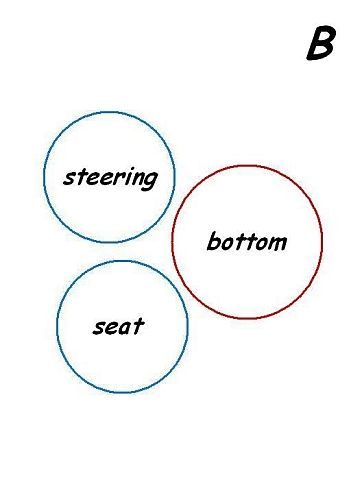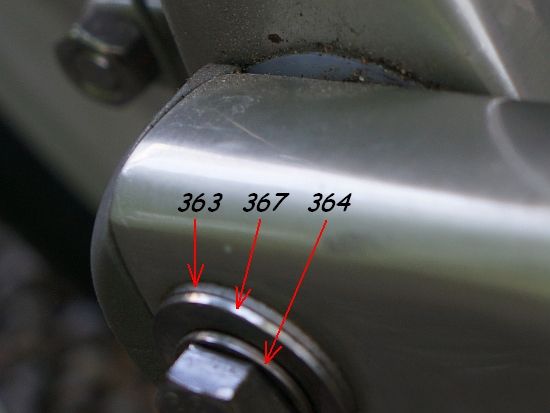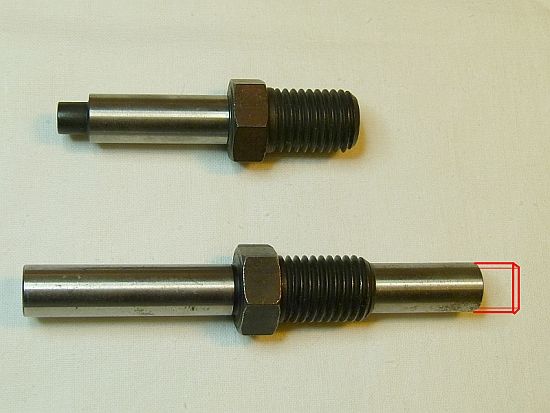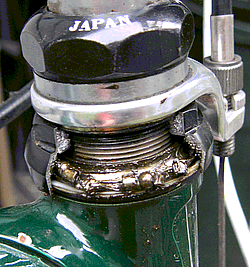BSA,
Thanks. Appreciate your help.
Don’t understand this bit. Why can’t we use a normal washer? What is too much spring preload?
BSA,
Thanks. Appreciate your help.
Don’t understand this bit. Why can’t we use a normal washer? What is too much spring preload?
If you add a common washer, like the yellow one, then you can see that by tightening bolt 373, you will make the cup spring completely flat. This would damage it.
So either you use a very thin washer like BSA did, or you add a spacer between washer 364 and axle 340 in order to fill the gap. The thickness of that spacer should be the same or slightly smaller than the thickness of the yellow washer. It will however be difficult to find such spacer, you will have to make it.
I hope my explanation is clear ![]()
Hello Bietrume,
thank you very much, your advice is always highly appreciated ![]()
As you say, at least one part has to be made.
Unfortunately there is still no info about the old 363, 367 parts, they must have used a thinner cup spring back then.
Hello Stccmc,
no problem, the explanation is a bit hidden in the technical data sheets of these cup springs…
As we can see are this springs very strong, that means a compression of the spring for just a few tenths of a millimeter will produce a very high spring load (or force).
Common standard washers are available in certain amounts of thickness only - for that size (12 mm) will the thickness be either 1,0 or 1,5 mm.
(You cannot order usual washers by thickness.)
Would you use an additional washer of normal thickness and tighten the 373 bolt,
then would the spring be compressed for an additional millimeter - the produced forces will be too high (too much load).
That was the reason to use a relatively thin material for the washer - on one hand;
and on the other hand - to reduce the spring’s height for the same amount (in the case above for 0,2 mm).
What might happen with a bad spring/washer combination?
I’m sure something of the following will happen:
To enhance your understanding and to explain what I’ve meant with preload please let’s have a look at a few special Strida parts - the joints.
Of course you’ve recognized that there are three joints on your Strida, at the corners of the triangle ![]()
From front to rear; the first is the one which can be unlocked, it is moveable in two ways;
a. Parallel to the steering tube for locking/unlocking
b. Around the axle of the locking mechansim for steering
The next one is the ball joint, it can be moved in two directions;
a. Left and right for steering
b. Forward and backward for folding
And the last one is the rear joint, did you notice that this joint does also allow TWO different moving directions (of the bottom tube)?
a. Around the rear axle for folding
b. Sideways movement of the bottom tube along/across the rear axle
This small amount of movement is necessary for folding, in the moment when the bottom tube has to pass the steering tube.
Without the cup spring would that not be possible 
In other words: If you fold your frame tubes like this
(pushing/pulling the bottom tube between seat and steering tube)

you can feel the force of the cup spring under full load - at this point in time does the cup spring her correct work!
That’ also the explanation why I’ve used before pre-load, most of the time will the load be relatively low.
But would we raise the pre-load much more than foreseen (with a thick washer) then must anything happen at the short moments of full load,
my guess is that first would break the bolt…
Hi Bietrume and BSA,
Thank you that was clear.
Bietume and BSA,
I was wondering how did the old strider version with 2x washers + cup spring work? The axle 340 threaded portion protude more from the bottom tube?
I have followed the suggestion here in the thread and filed down the sharp edge of cup spring (step 2), does it mean the spring loading is now too weak? I don’t notice anything usual after a 20km ride except it is now silent.
I hope there is a permanent solution and In the mean time I am quite happy to apply grease (or WD40) once in a while.
Included in my next order from Strida is the plastic clip used in with EVO to hold the bike in the folded position. Would it be possible to reconfigure the rear tube joint so the joint would not have the sideways movement needed to fold the bottom tube into the down tube? Then use the clip to hold the front tube in place while folded. Just an idea, what do you think?
Bill Wilby http://www.stridacanada.ca
If you have replaced the weak and probably deformed washer 364 by a stainless stell one, then it should not make a big difference in spring loading.
Bill,
I think it would be a good solution. That was also my thought when the EVO came out with the plastic clip, see my post of January 3, here: wheezing sound from crank hub?
Exactly what I think…
Possible that the axles are different, at least the part number is.
I guess that Ming used for 363 and 367 material of different thickness to that of the new 367-3 shim.

(Anyway I’ll try to order all three parts asap for comparison.)
Don’t worry, I don’t think so…but you might compare your file work to the edges of the pics above.
Did you file much more than just the edge round or did you use an electric grinder?
Me too, meanwhile you might also use the above/below mentioned plastic part to save lifetime of the rear joint.
However, I think we should ask Ming cycle for the reason to skip the washer.
If you’re speaking Chinese - what I suppose - you could be very important to explain the issue to Ming!
@Bill and Bietrume:
Agree.
It seems better to use generally the plastic part to reduce wear of the critical rear joint.
(For the EVO is the plastic part a must due to the heavier bottom bracket.)
But unfortunately that might lead to another little problem - where to get this part?
At least for Vanmoof it’s not possible to order (?), as they already told me by request.
(Dear friends brought a few of this plastic clamps directly from Taiwan to the last Eurobike in Germany ![]() ).
).
Oh, you mean so that we don’t have to bend the bottom tube a little to lock it between the seat tube and the steering tube when folded? Like the mini? I don’t know how that work in a EVO. I will ask around if that is available to order from here.
Yes - exactly!
It,s just a simple plastic, let’s say “doubled clamp”, you can see it for example at the The 3-speed Strida post.
BSA,
I checked the local retailer, they carry this plastic double clamp part. Not sure the pricing yet.
Why are messages doubled up every time?
Guess that part cannot be expensive…
Sorry, no idea where the doubled messages are coming from, maybe (another) bug of the forum software (?).
You might try to use the preview button before hitting “submit”, if the issue still consists I’ll ask the admin for help.
Are you sure to have clicked the “submit” button only once?
And don’t worry, it’s very easy to delete the unwanted twins ![]()
I’m afraid the plastic part will not reduce the wear of the rear joint as long as a cup spring is used: the rear joint suffers from the dynamic pedaling forces which tend to continuously rotate/twist the bottom tube. When you pedal hard, you will indeed notice a lateral displacement of the bottom bracket, which is mainly due to the flexibility of the rear joint. This is also why you hear the creaking noise when pedaling.
So, to me, the plastic part makes only sense when used with a classic hinge mechanism at the rear, or to help with a heavy bottom bracket.
Bietrume,
thank you very much for teaching and sharing your knowledge 
Once again I’ve got here the explanation for a phenomenon which was easy to find - by trial and error - but hard to understand.
It was clear soon that it must be the edge, but I had no idea for the source of the movement - until yesterday…
Yeah, but how to create a classic hinge mechanism (construction change by Ming excluded)?
If we would use flat shims/washers instead of the cup spring we will also need additional parts:
It must be possible to adjust the hinge’s play (fabrication tolerances and wear will require that, I mean).
BSA,
You are correct about the tolerance compensation. I think that on classic folding bikes, the play in the hinge mechanism is no issue because there is an extra locking device, which is not the case here.

Looking back at the diameters of the axle and of the bottom tube hole, the radial play of about 0.2 - 0.3 mm is enough to allow the angular movement of the bottom tube for folding.
In a proper hinge mechanism, the plastic piece should be replaced by a steel one with much less radial clearance and it should be fixed in the bottom tube by some screws, not simply pressed into it. Then there should be a lock nut to adjust the lateral play of the bottom tube on the axle.
Not easy to retrofit on a Strida, especially the lock nut. But knowing you, I’m sure you will find a solution ![]()
I’m reading all your notes, replies ,suggestions regarding the ‘clicking’ noise in the Strida and thanks for all your good ideas.Very interesting indeed and educational.
I had the same issue on my Strida SX ,which is new and just clock-in 120kms. from mid-November 2013.
Before the clicking noise happened ,my Strida also developed another sound ,and after careful observation on my morning rides, first, I noticed that the sound is coming from the front wheel rubbing against the screws of the fender, creating an intermittent rubbing sound.When I removed the front fender, the rubbing sound was gone (problem solved) ![]() , BUT another sound appeared and this time around the “clicking” noise which is also intermittent ,sometimes happening at uphills, sometimes downhills
, BUT another sound appeared and this time around the “clicking” noise which is also intermittent ,sometimes happening at uphills, sometimes downhills ![]() .
.
Yesterday, another big surprise to me is the rear wheel (also with fender) after cleaning the sides of the rear wheel, using my torchlite to see , I was surprised to see that the side wall of the rear wheel is already scraped off (I hiope I can post the photo of my wheel showing the scraped side) due to rubbing against the fender mounting screws. It seemed that the clearance to the wheel is too small and when under load during my rides it tended to expand and rubbed against the screws.I had removed the rear fender to solve the problem and bought a new spare tyre just in case the damaged tyre give way.I do not know if this happened to any other Strida SX users using 18" wheels?
But my focus now is more on the "clicking’ noise and I will follow this thread…
Thanks for your trust, but actually the solution is very easy - unfortunately not suitable for (DIY) retrofitting:
All we need is a slightly different rear axle; instead of the internal M 8 thread a simple M 12 male thread like below
(Which would be also an advantage for the fabricating of the axle!)

Guess that M 12 self securring nuts are available in lots of types everywhere.
So it’s done… ![]()
We just need to convince Ming… ![]()
Thanks for your interest!
I mean your tyre - screw issues are very unusual, no idea how that could happen.
Maybe we can find out more with pics, please let me know if you need assistance!
It’s really no problem to host/upload a few pics for you ![]()
Image posting at Stridaforum.com in 5 steps
@ BSA,
i will try to post the photos of the affected rear tyre (due to fender screws rubbing) next week after my short weekend holiday in malaysia.
again, thanks for all the replies and educational discussions here in this forum.
I agree with the external thread but you need a much finer thread (max 1 mm) than the standard 1.75 mm in order to do fine adjustment of the play. Take example at the old bike headset adjusting nuts which have fine thread as well:

I think a retrofit would be possible by selling a kit with following parts:
One modification would be needed to the frame: drill 2 holes in the bottom tube in order to fix the insert with screws. This could be done by the owner if a drilling template would be supplied with the kit.
If a kit was for sale at less than 75 EUR, then I would for sure buy it ![]()
Question related to the picture you posted: which axle is shown on the top?